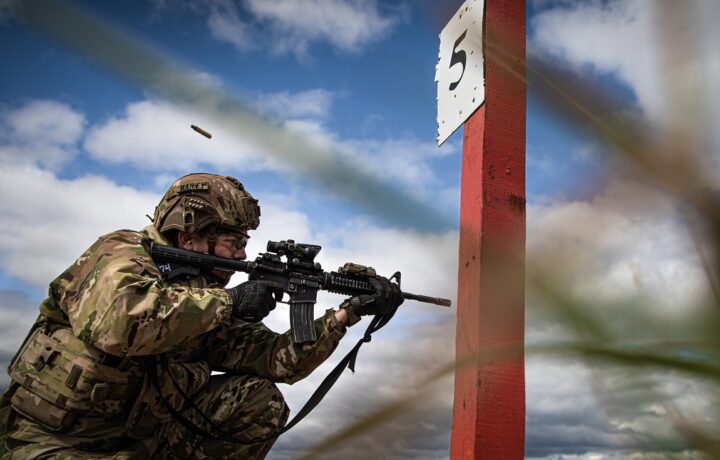Though their history goes back centuries, the machine gun reached its grim apotheosis during World War I as a weapon of terrifying power and utterly devastating force—particularly when combined with wire obstacles. For that reason (and so many horrible others), the first world war is a sort of dividing line in ground combat. There is before the machine gun, and after.
Like all weapons, they have changed over the years (though less than you might think), and so here is a look at machine guns that have laid down fire in the last ten years—and a couple that might be coming to a battlefield near you.
Ma Deuce. The M2 machine gun was designed in 1918 by John Browning himself. (Though World War I was still being waged at the time, it never saw action in that conflict.) So perfected in the worst ways imaginable was the M2 that American soldiers have used it in every military conflict since World War 2. (Including this solder, in Afghanistan.) Indeed, it is the second-oldest weapon in the U.S. arsenal, behind the M1911—also designed by Browning. The man just knows how to give the taxpayer their money’s worth.
XM250. It’s a shame that the U.S. Army couldn’t buy American, but the XM250, made by German manufacturer SIG-Sauer, was developed as part of the Next Generation Squad Weapon program, set to replace the trusty M249 SAW. It fires .227 rounds specifically because body army worn by enemies has gotten better at protecting the enemy from .556 ammunition. This year, the first batch of this light machine gun will roll out to an infantry battalion near you.
M61 Vulcan. Ah, the Vulcan cannon. When you absolutely, positively need to put six thousand rounds of 20mm lead downrange. The General Dynamics enemy liquifier, based on the Gatling gun, has been spraying death from fixed-wing aircraft since the Vietnam War, with no end in sight.
Phalanx CIWS. Sure, the Vulcan is nice, but you know what is nicer? Giving it a computer brain and a radar targeting system, and mounting it to ships to kill enemy missiles and planes automatically from as far as five nautical miles. Note: Because it’s the Navy, you have to pronounce every absurd acronym, including CIWS. You call it a “sea wiz.”
MG 338. One day, Ma Deuce will be the exclusive domain of, uh, dedicated hobbyists (it is legal to own a machine gun), and base museums. Marine Special Operations Command started testing the SIG Sauer-made MG 338 in 2020, designed to replace both the M249 and the M2. Considering it can punch through soft-skinned vehicles at a thousand meters, you can see why the Marines would be interested. (The Army is, too.)
M240L. The American military has been using the M240 since the 1970s. Just as I was getting out of the Army, the M240B was entering service, replacing the trusty ol’ M60. Well, now the M240B is old news with the arrival of the M240L, which is five pounds lighter than the previous model, without sacrificing performance. (It still looks the same, though.)
Mark 48. U.S. Special Operations Command brought in the Mark 48 about twenty years ago to replace the M60, and the Mod 2 is the latest iteration, with a better range and accuracy, a svelte ten pounds lighter than the M240B, and firing 7.62 rounds. There is even a backpack-mounted ammunition system that makes every soldier look like a character in Warhammer 40,000.
FN EVOLYS. Sometimes you want a machine gun, but you don’t want to lug around a machine gun. The FN EVOLYS is here to help. The “ultralight” machine gun was designed from the first day to be used in urban warfare, and fires 5.56 and 7.62. Just to hit all the buzzwords, the weapon is entirely 3D printed, and weighs a mere 12 pounds, which is slightly less than double the weight of an M16 rifle. It hasn’t rolled out yet, but give it a few years.
M1910. Wait a minute, you might be about to say. The M1910 is over a hundred years old! Why are you featuring it on this list of new and emerging machine guns? Because if you are a member of the Ukrainian military, you might be firing an M1910 even as I type this. Ukrainians are using the very same weapon that got World War I dubbed “the machine gun war” not because their people are poor, but because the M1910 is water cooled, keeping its barrel from overheating. Which, when you are trying to fend of an invasion army, is a pretty good tool to have in your arsenal.
The Railgun. I’ve been hearing about railguns my whole life (indeed, so did my grandparents; the concept first came around in 1918, the same year John Browning designed the M2). The idea has always been to build a machine gun that could use electromagnetic forces to fire projectiles rapidly. A conventional firearm might have a muzzle velocity of about Mach 5.9. A railgun, however, would easily speed past Mach 8. The problem is that no one has figured out how to make a rifle variant that can meet the power, thermal, and durability needs of an infantryman. Defense Department research laboratories have not given up on the dream, however. And when they do, the Army will draft me. If I learned one thing in college, it was how to fire a railgun like a master.




